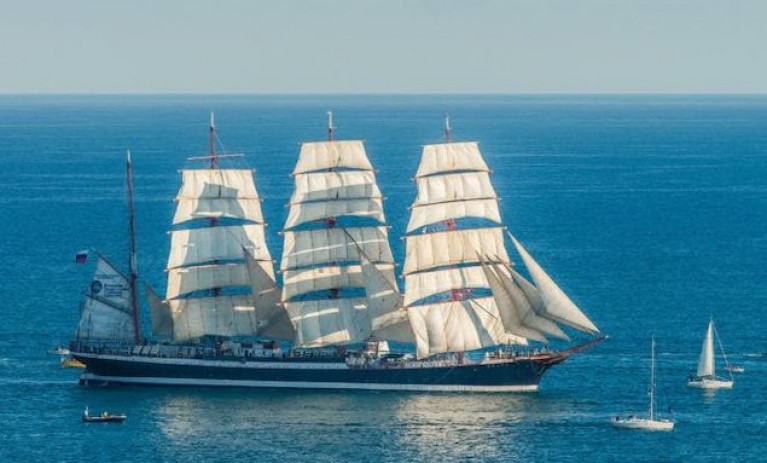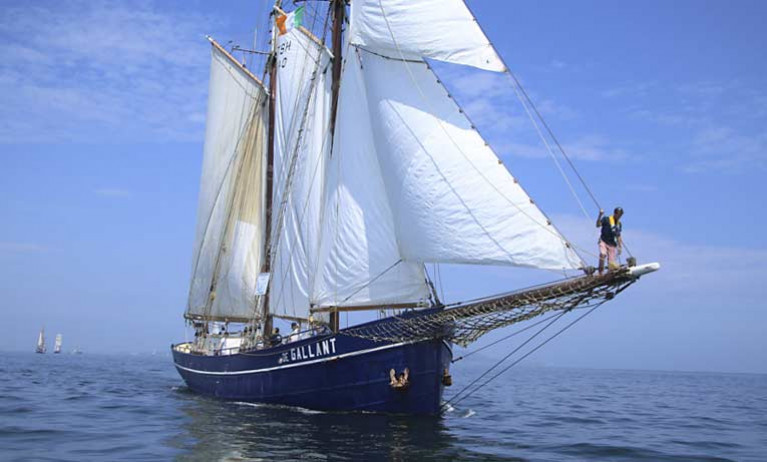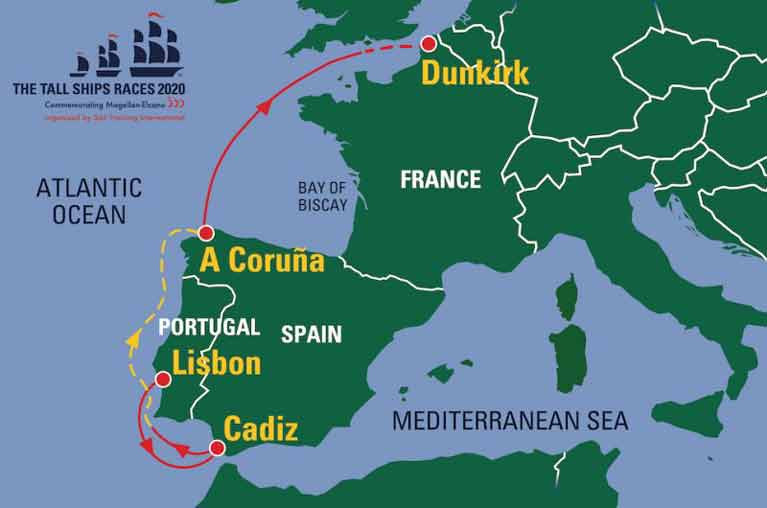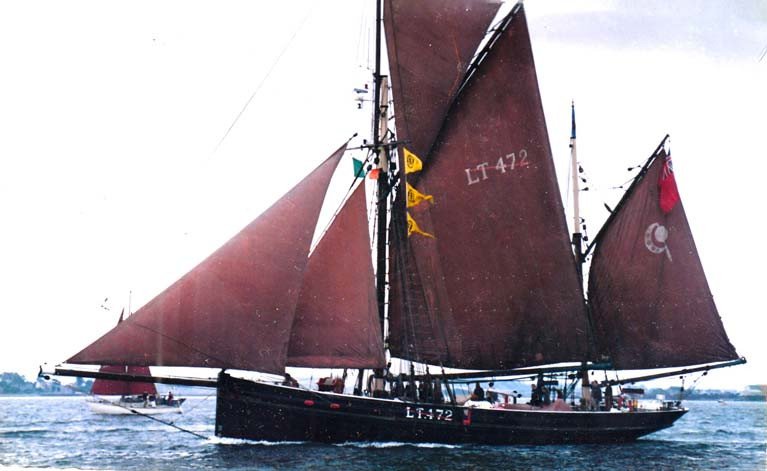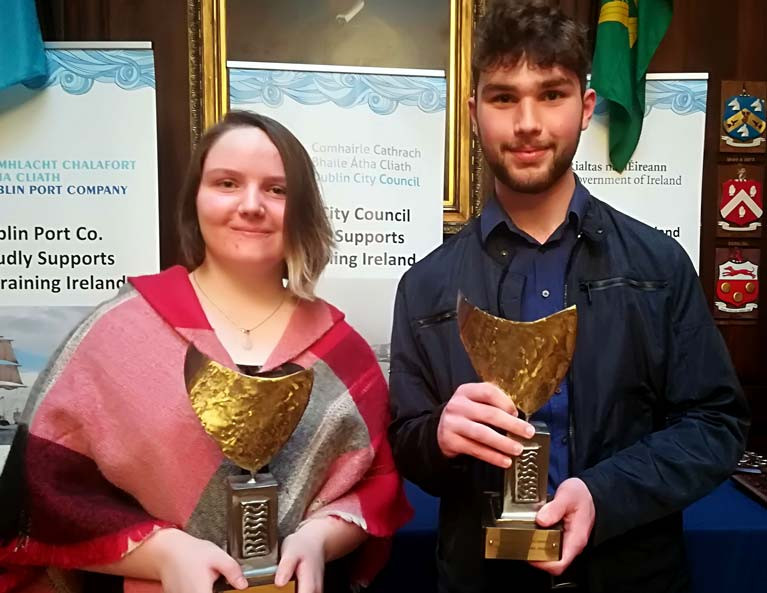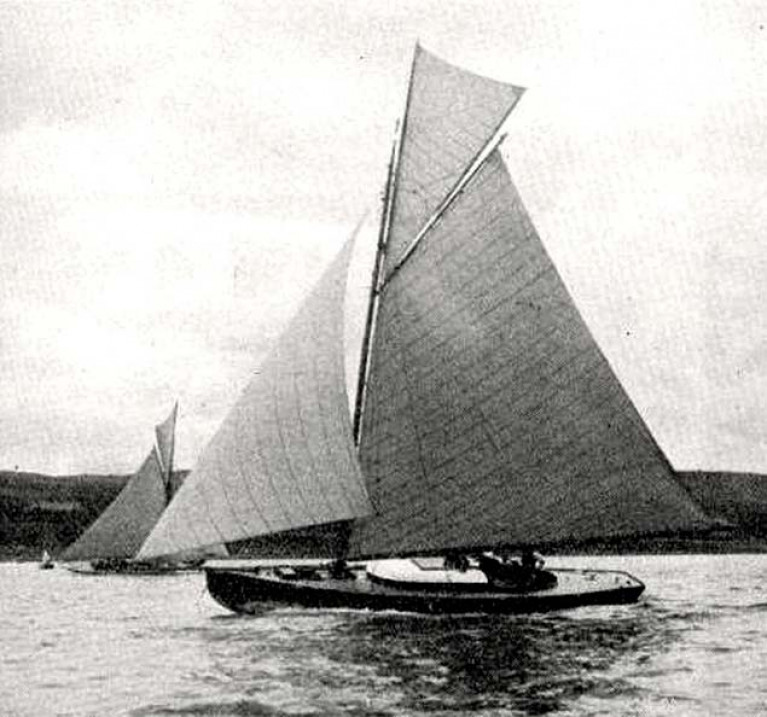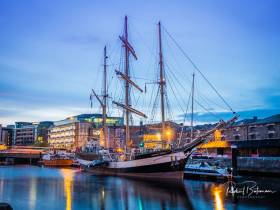Displaying items by tag: Tall Ships
Lerwick has been selected for the third time to be a host port for the spectacular Tall Ships Races.
Sail Training International, the operator of the Tall Ships Races, has today (Tuesday 11 May) announced the selected host ports for the 2023 series, with the Races expected to visit Lerwick, the only Scottish location, from 26-29 July. The isles previously hosted the event in 1999 and 2011.
Shetland Islands Council has led the isles' successful bid, in partnership with Lerwick Port Authority and Shetland Tall Ships Limited, which will undertake delivery of the event locally. Many other organisations are supporting the event, including EventScotland, part of VisitScotland's Events Directorate, and Sail Training Shetland.
Steven Coutts, Leader of Shetland Islands Council: "It is tremendous to get a final confirmation of this news. We have a strong history of delivering memorable Tall Ships Races here in Shetland; they hold a special place in the memories of so many in our community.
"This is a fantastic opportunity to celebrate Shetland's rich maritime heritage and promote Shetland internationally. It will provide a valuable boost to our economy and community as we move into recovery and renewal."
Sandra Laurenson is Interim Chairman of Shetland Tall Ships Limited: "It is very exciting to have the opportunity to bring the spectacular Tall Ships Races back to Lerwick. With just over two years to go, there is plenty to do, and, building on our experience of the two previous visits, we'll now be establishing organising committees, appointing a project manager, fund-raising and developing a programme of events and entertainment for islanders, ships' crews and visitors.
"The event is a great opportunity to rebuild, and we very much look forward to working with the community on the broad appeal of the Tall Ships Races event."
Captain Calum Grains, Port Authority Chief Executive: "The announcement of the Tall Ships' return would be great news at any time, but particularly so during the gradual recovery from the pandemic, and it gives Shetland something exciting and positive to look forward to, and contributes to the promise of better times ahead.
"The colourful visit will provide a major event for the community, a showcase for island products and culture, a boost for the economy and enhance Lerwick's international reputation as a tall ships-friendly port."
Sail Training International Chief Operating Officer Alan James: "We are delighted to announce Lerwick as one of the Host Ports of The Tall Ships Races 2023. We have immense pride in our rich history together and are excited to return to the Shetland Islands for the first time since 2011. With a rich maritime history, shared values of international friendship and understanding, and a strong record staging events, we look forward to Lerwick welcoming the Tall Ships fleet in spectacular style once again."
Paul Bush OBE, VisitScotland's Director of Events: "The confirmation of the return of the Tall Ships Races to Lerwick is great news after they successfully hosted the event in 1999 and 2011, and EventScotland is delighted to be supporting the return of the event in 2023. Hosting major events will be a key part of Scotland's recovery from Covid-19, and Tall Ships will be a significant driver in helping rebuild and support the tourism and events sector in Shetland. "Scotland is the perfect stage for events, and Lerwick's selection as a host port for the race will provide us with a wonderful opportunity to showcase the region's amazing scenery and culture to an avid audience of sailing enthusiasts."
The ports were announced today (Tuesday) by Tall Ships Races International Ltd, a subsidiary of Sail Training International, which describes the event as 'Europe's largest, free family festival', you can find more information on their announcement here
99-year-old Russian Tall Ship Sails Through an Ice-free North Channel
The Russian Tall Ship, Sedov, has reported a successful transit the full length of the legendary Northern Sea Route.
After departing from Vladivostok, Russia in mid-August, the Sedov completed the east-west passage passing the southern tip of the Novaya Zemlya archipelago, the easternmost point of Europe. She is expected back in Russia at Murmansk next week.
The ship was originally built in Germany in 1921 and was acquired by the Soviet Union in 1945 as war repatriation.
The journey was made possible due to unprecedented low levels of sea-ice, in some places no ice at all.
The Sedov is a four-masted, steel-hulled barque, almost 100 years old, that is one of the largest of its type in the world. She has visited Ireland a number of times for tall ships events. It is currently operated by Russia's Federal Agency for Fishery. In addition to the ship's usual crew, onboard were 136 cadets from the Baltic State Academy of the Fishing Fleet, the Kaliningrad Maritime Fisheries College and the Murmansk State Technical University.
"We have sailed across practically the whole Northern Sea in open waters and we have not run into any crushed sea-ice, nor icebergs," said Mikhail Novikov, Captain-Supervisor of the Sedov. "We expected that at least."
Sail Training Ireland Announces 2021 Tall Ships Voyage Programme (Downloadable Here!)
Sail Training Ireland has announced the launch of its 2021 Tall Ship voyage calendar (download below) coming after the disappointing decision to have to cancel its 2020 voyages due to COVID-19.
Next year will see some new and exciting projects happening alongside Sail Training Ireland's usual local bursary scheme voyages.
Most of the charity’s voyages have generous bursaries available to reduce the cost to those who may not be in a position to avail of the opportunity because of their circumstances.
Due to pent up demand arising from this year, STI says it is advisable to book early.
“One of the key skills that sail training teaches is resilience. Our trainees, crews, supporters, sponsors, volunteers, vessel operators and the Board and staff have had their spirit tested during 2020 and come through it even stronger. We cannot wait for the 2021 season to start and will be working hard to make it the best one ever". "Please come and join us”, said Daragh Sheridan of Sail Training Ireland at the launch.
2021 Voyage Calendar (download below)
Sail Training Ireland has confirmed the difficult decision to cancel all its Tall Ship voyages for 2020 due to the ongoing impact of the Covid-19 virus.
The objective of STI is youth development rather than just teaching people to sail. In 2018, Sail Training Ireland placed 341 young people on sail training vessels, over 90% of whom were from disadvantaged backgrounds.
As Afloat's Tom MacSweeney reported earlier, while there was a small possibility that some activity could have taken place at the later phases of the Government easing of the lockdown, it was felt that there was no way to ensure the social distancing required to ensure the safety of the trainees and crew.
Sail Training Ireland does not own or operate is own vessels, but charters as required. This is a different model to the state’s previous sail training vessel, the Asgard, which sank off the coast of France in 2008.
This is very disappointing news for over 400 young people who were due to take part this year. All trainees who were booked on voyages have been offered the chance to change to new voyage dates in 2021 or to receive a full refund.
It is also a very difficult time for sail training vessel operators who face a full season without any sailing.
Sail Training Ireland will publish their full 2021 calendar of voyages next week and bookings for those voyages can be made on their website.
“Like all charities this is a difficult time for Sail Training Ireland, but we are delighted that all our fantastic supporters and sponsors are fully behind us and the work we do. I would like to thank them for their wonderful support, and we look forward to an exciting 2021” Daragh Sheridan, CEO of Sail Training Ireland.
Tall Ships Races Postponed to 2021
Sail Training International has announced that due to the COVID-19 outbreak the Tall Ships Races 2020 has been postponed until next year – the first time this has happened since the event was first held in 1956.
The Tall Ships Race is a huge public celebration of youth development and international friendship. During the Cold War years, it was almost alone in bringing together large numbers of young people from both sides of the Iron Curtain – an achievement that resulted in a nomination for the Nobel Peace Prize in 2007.
In 2019, over 4,000 young people from 59 different nations took part on 87 vessels. Nearly 6 million visitors went to see the ships in six different ports. The 2020 event was scheduled to start in Lisbon on 2 July and finish in Dunkerque on 9 August, visiting Cadiz and A Coruna en route.
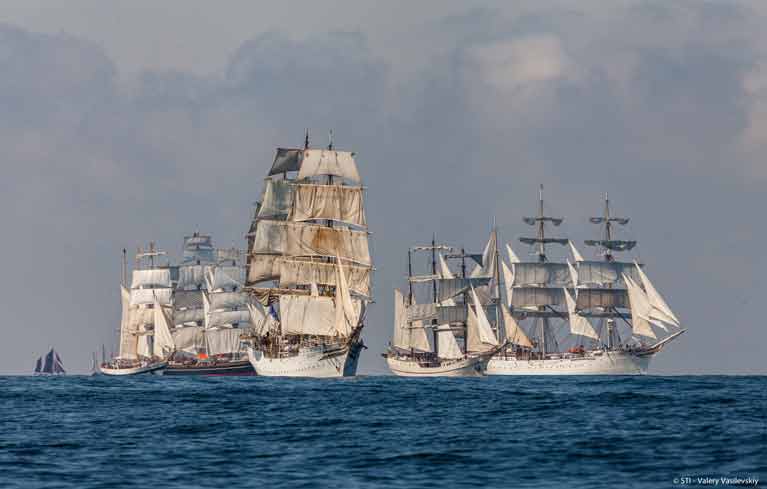 (From left-to-right) Pogoria of Poland, Sorlandet of Norway, Artemis of Netherlands, Statsraad-Lehmkuhl of Norway taking part in the Tall Ships Races Photo: Valery Vasilevskiy
(From left-to-right) Pogoria of Poland, Sorlandet of Norway, Artemis of Netherlands, Statsraad-Lehmkuhl of Norway taking part in the Tall Ships Races Photo: Valery Vasilevskiy
Jonathan Cheshire, Chair of Sail Training International, the UK-based charity that coordinates worldwide sail training, said:
“It is a great sadness to us and this year’s host ports to have to postpone the event until next year, but we all agree that a public gathering of this size is out of the question in the midst of a pandemic. We feel for all the young people who will be disappointed by the decision, but public health and safety must take priority. The financial impact on the charity will be serious, but survivable; and before the outbreak, we had just commenced a search for new sponsorship to put the event on a more secure long-term footing.
“We are determined that the postponed event next year will be as rich and rewarding an experience as usual. The interaction between young people from so many nations, on board and in port, is a powerful catalyst for cross-cultural tolerance and understanding. The experience of life at sea gives young people unparalleled opportunities to learn responsibility, self-confidence, trust, and teamwork. In our highly managed and mechanised world it offers unmediated contact with one of the last great wildernesses.”
Tall Ships Cork-Belfast in 1991 Evokes Sailing Memories
Lock-down leads to break-out. I hadn’t heard from Graham Diamond in years. But a pre-coronavirus DBOGA talk in Poolbeg Yacht Club in January by Peter Lyons and Stu Spence of Strangford Lough about racing the latter’s 34ft 1910-built Vilia as the smallest boat in the 1991 Cork-Belfast Tall Ships Race had jogged memories of doing the same race aboard the restored 1921-vintage 77ft Lowestoft trawler ketch Excelsior.
And now Graham Diamond, watch leader and ace ship’s cook on the same vessel for the season of 1991 under the command of Rob Bassi of Belfast, has been in touch out of the blue from Trinidad. He’s been Caribbean-based since 1992, and earns a crust doing – among other things - yacht deliveries, the last one before the clamp-down being a New York to Trinidad hop starting in November with a Frers 38, which sounds a very attractive type and size of boat, whatever about the time of year for sailing from New York to Trinidad.
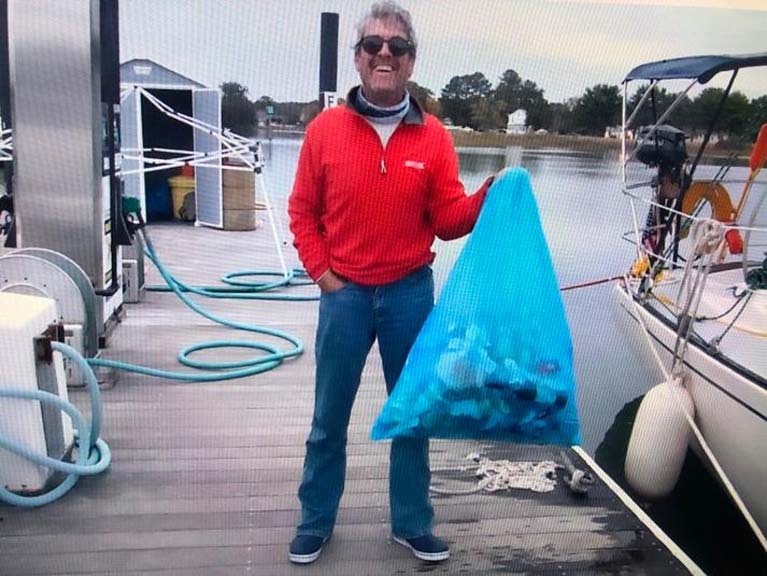 The last hop before the lock-down. Graham Diamond looking to the environmentally-friendly waste disposal after his New York to Trinidad delivery of a Frers 38.
The last hop before the lock-down. Graham Diamond looking to the environmentally-friendly waste disposal after his New York to Trinidad delivery of a Frers 38.
However, these days the only deliveries anyone is concerned about on either side of the Atlantic are from the few neighbourhood core supplier still allowed to operate, while online trade is rampant. But in cyber-space, people are sailing everywhere with shipmates old and new in boats of all types and sizes, and thanks to the September/October 1991 Afloat, we can wallow in the report of the doings of the Tall Ships in the Cutty Sark Tall Ships Races of 1991, for in those somehow sweetly innocent days, nobody thought it all odd that a booze company should be very actively sponsoring sport for young people.
Looking back, the 1990s were probably peak time for the Tall Ships and Sail Training movement. Certainly, the enthusiasm in Cork and Belfast was infectious, and something like 90 vessels of all shapes and sizes – including some very big ones – took part.
For the life of me I can’t remember how I came to be aboard Excelsior. But in those pre-internet-dominant days, I was churning out the merchandisable nautical verbiage for at least half a dozen regularly-printed publications, and the machinery consumption was one Olivetti Lettera 32 typewriter worked to death about every eighteen months. The first sign of typewriter mortality would come when the carriage – having been flicked across at the end of a line – simply continued to fly across the room, trailing typing ribbon behind it.
This meant there always had to be a replacement typewriter in the work-room cupboard, but at least regular deadlines and specific publication dates punctuated the working week, and you could plan to go off and do things on the sea with ships large and small.
Consequently, on this gentle July morning, I found myself ambling (with rolling gait, of course) along the crowded, sailing-ship-packed quays of Cork with the kit-bag over the shoulder (I’m not making this up), wondering did I dare ask people to call me Ishmael. And after heaving the gear aboard Excelsior and barely having time to savour her Stockholm tar aroma of authenticity, we were away for the high seas, and on towards the low and high life of Belfast, with Ireland’s own Captain Tom McCarthy and Asgard II as flagship.
As it happened, our crew on Excelsior seemed mostly to be from some posh English girls school, all with names like Annabelle or Fiona or Sally, nice gels whose strongest oath within earshot of the afterguard was “Oh Gosh”. Maybe they swore like troopers among themselves, but they were perfectly charming when serving up the superb food which Graham somehow found the time to create in the workmanlike galley, and on deck they were gallant at every task set, quickly learning that a proper tackle led from the rail is the only way to control a tiller which extends from here to the middle of next week.
Unfortunately, in order to preserve the back numbers of Afloat and its direct predecessors, I’ve had them neatly but rather tightly bound in one volume for each year. This has certainly kept them together, but we can’t get a full scan of the pages without breaking the binding, so you’ll have to guess some of what’s in this almost-three-decades-ago account from Afloat Magazine, Sept/Oct 1991.

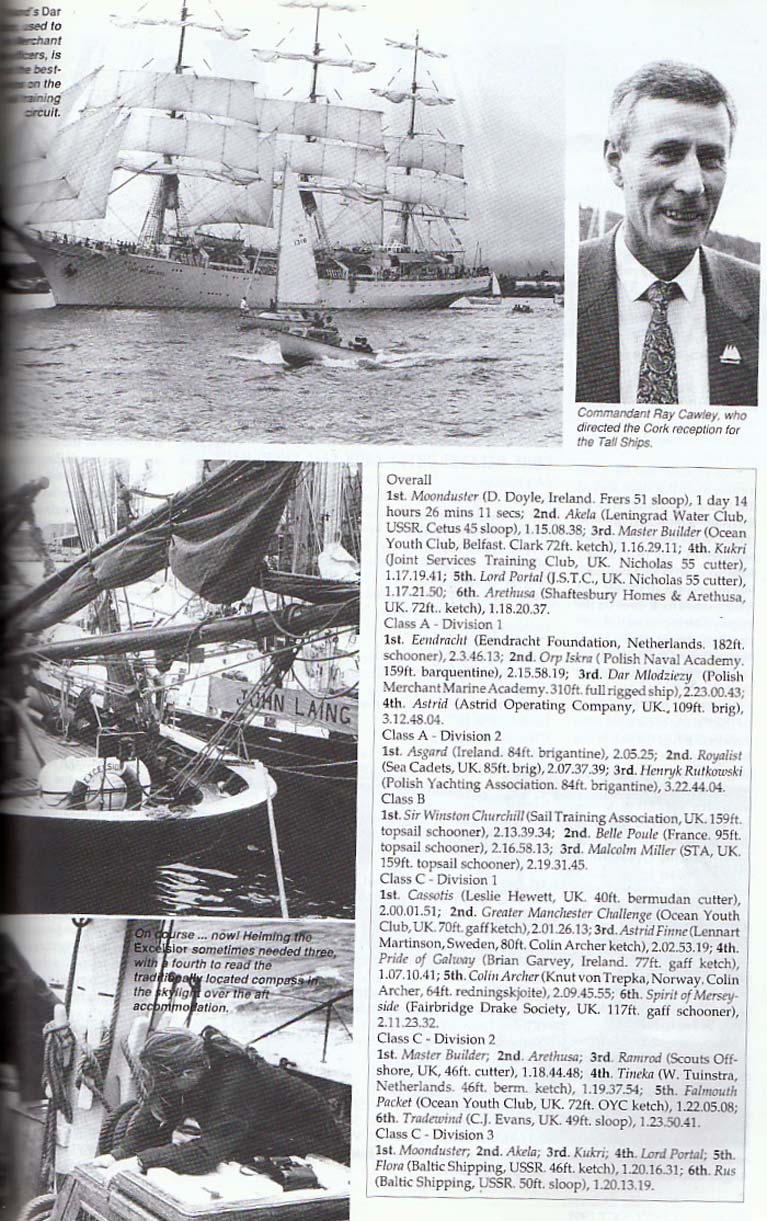
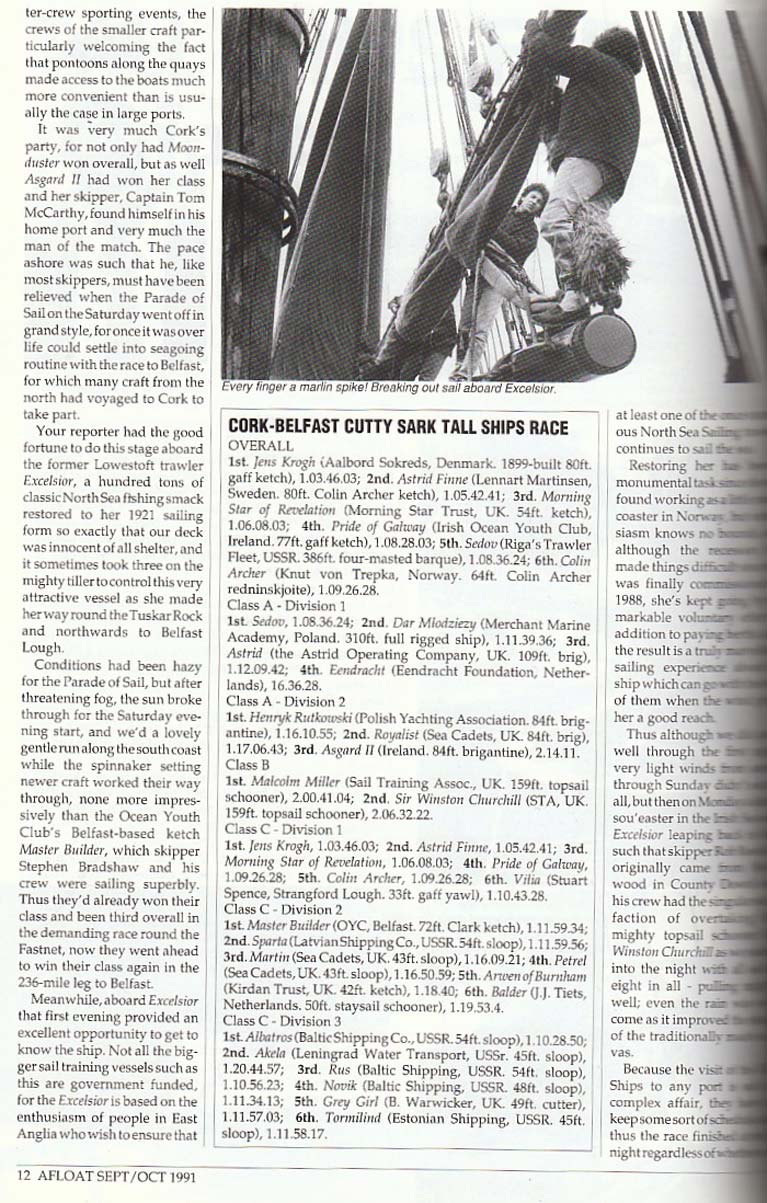

Sufficient to say that while Excelsior was a flyer on a reach, too much of that race was dead downwind for her to be at her best, and though we came zooming past the South Rock in the final stages in a rising sou’easter going like a train, it wasn’t enough to get us into the frame. But as the Massachusetts whaling skipper said after going clean round the world without seeing so much as one whale, let alone catching any, at least we had one helluva fine sail….
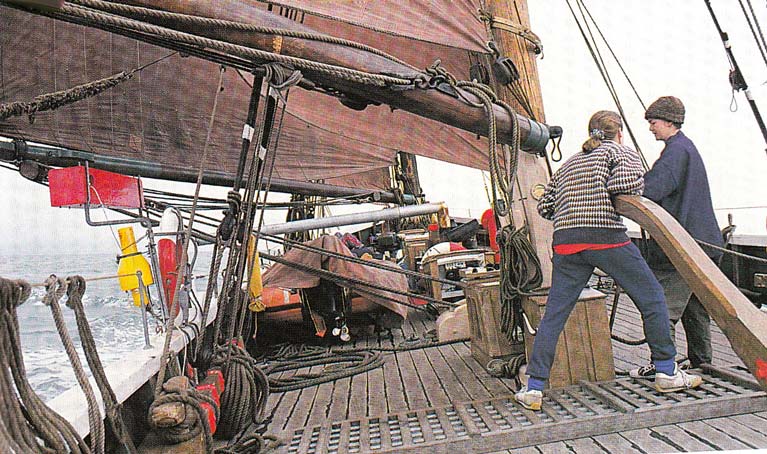 Tiller girls….,Excelsior making knots in a rising sou’easter off the County Down coast. Photo: W M Nixon
Tiller girls….,Excelsior making knots in a rising sou’easter off the County Down coast. Photo: W M Nixon
Afterwards, having helped the citizens of Belfast to drink their hospitable town dry, the fleet raced on west of Scotland and eventually to the finale in Delfzijl in The Netherlands where – after all the routine prizes had been given out – the high point came with the mystery award of the Cutty Sark Trophy for the ship and crew which had best embodied the ideals and spirit of the Tall Ships Movement. It went to Captain Tom McCarthy and Asgard II. Things just don’t get better than that.
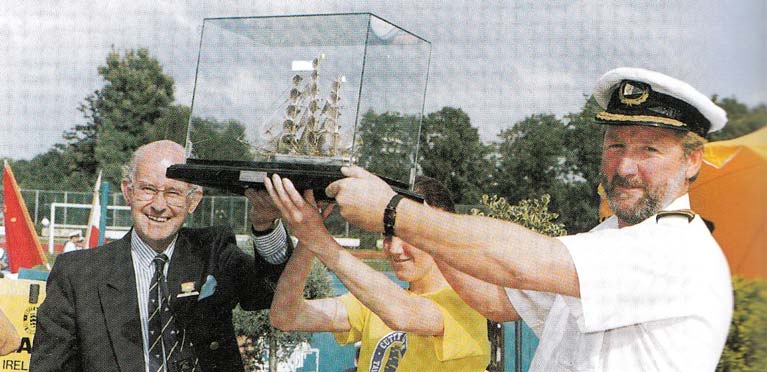 It just doesn’t get better than this….Captain Tom McCarthy and Asgard II receive the Cutty Sark Trophy 1991 at Delfzijl in The Netherlands from Oliver Pemberton of Cutty Sark.
It just doesn’t get better than this….Captain Tom McCarthy and Asgard II receive the Cutty Sark Trophy 1991 at Delfzijl in The Netherlands from Oliver Pemberton of Cutty Sark.
Drogheda Students Recognised at Sail Training Awards
The “Drogheda Sail Training Bursary” was once again highlighted at the Annual Sail Training Ireland Awards Ceremony last week in the Mansion House. The CEO of Sail Training Ireland, Mr. Darragh Sheridan acknowledged the Drogheda bursary scheme as the first of its kind back in 2013, encouraging many other port towns and cities to follow suit. Fast forward seven years and there are 8 of these local bursary schemes operating throughout Ireland in association with the national charity, Sail Training Ireland.
It is true to say pre-2013 Maritime facilities for such opportunities as this in Drogheda were non-existent, so the Drogheda Port Company set out to change that through Sail Training. Since then 140 local teens have been gutsy enough to experience this influential sailing experience that often has a profoundly positive effect on their outlook on life and career choices. Some trainees have progressed to longer voyages on bigger tall ships, while others are now sitting on the Sail Training Ireland Youth Council and even pursuing maritime careers in the Navy. These developments are a testament of how much this Drogheda Sail Training youth development program has grown since its maiden voyage back in 2013.
At last week’s Awards Ceremony, local students, Erin Englishby of Colaiste na Hinse, Bettystown and Ronan Collins of St. Joseph’s C.B.S, Drogheda were both presented with the Perpetual Trophy for ‘Outstanding Trainee’ on their respective voyages in June 2019. Their vessel Captain, Mr. Peter Scallan who presented these awards, described these trainees as valuable, committed leaders who enriched the experience of all onboard. Both students are keen to continue sailing and are hopeful of upskilling on progression voyages later this year.
The continued support of the bursary sponsors is the key driver of this initiative; Irish Cement, Fast Terminals, Louth County Council and Drogheda Port Company make this possible.
Ireland’s Small Tall Ship will Brighten a Winter’s Night in Dublin
Tall Ships and Sail Training? Everyone will immediately think of stately clipper-bowed cathedrals of sail making their elegant and timeless way across the high seas, driven along under acres of square-sailed cloth, spreading the gospel of international fellowship and the benefits of sail training.
But the many training associations worldwide have to live in the real world. Much as they all like to have their international Parades of Sail dominated by such magnificent Tall Ships, they know that many sail training vessels are much more modest craft. So for their inter-port races, the fleet is divided into classes which – at the lower limit - include smaller fore-and-aft rigged cruiser-racers which can qualify simply by being of reasonable size and carrying the minimum required proportion of trainees in the crew.
Yet as far as the general public is concerned, it’s still a Tall Ships Race. And one of the most spectacular staged in Irish waters was back in 1991, when a huge fleet raced from Cork to Belfast, with our own late lamented Asgard II – skippered by Captain Tom McCarthy – as flagship.
It was months – indeed years – in the planning, and during that time a young Northern Ireland sailor, Adrian “Stu” Spence, was pleased to find that his 1910-built gaff yawl Vilia was big enough to qualify, as her hull was 37ft in length when the lower limit was 35ft, while by adding in the bowsprit and the mizzen boom, she clocked in at 45ft.
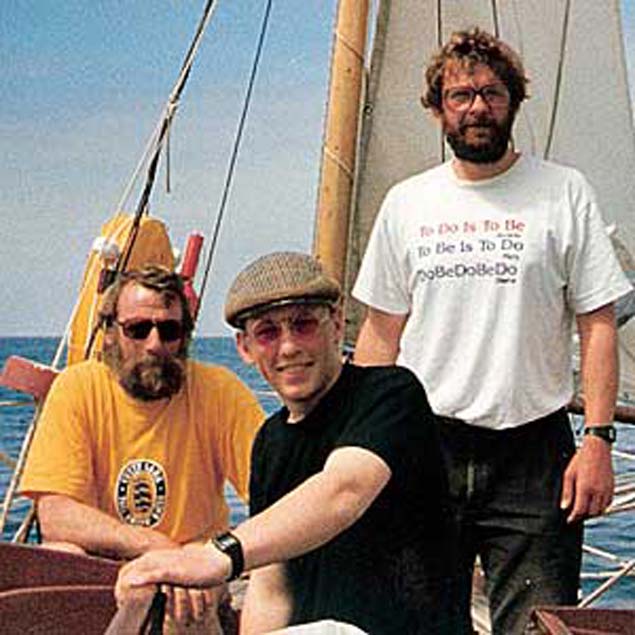 Peter & Gary Lyons and Stu Spence aboard Vilia for the Cork-Belfast Tall Ships Race 1991
Peter & Gary Lyons and Stu Spence aboard Vilia for the Cork-Belfast Tall Ships Race 1991
Thus Vilia qualified comfortably, and with his old friend Peter Lyons as First Mate and Peter’s son Gary as one of the trainees, Vilia made her way to Cork from Portaferry and raced back to Belfast in style, finishing with many bigger boats astern.
Since then, Stu Spence has become internationally known as the long-time owner of the former pilot cutter Madcap, which was built in 1874, but her great age didn’t hold him back from some remarkable voyages. And as it was that early experience with Vilia in 1991 which led on to these achievements, it is now time and more to remember a special boat and that Tall Ships race of nearly thirty years ago.
 Stu Spence’s 1874-built former pilot cutter Madcap in Greenland in 1998. Photo: Frank Sadlier
Stu Spence’s 1874-built former pilot cutter Madcap in Greenland in 1998. Photo: Frank Sadlier
Stu and Peter have put together a show about it all, and it’s being presented as part of the Dublin Bay Old Gaffers Association Winter Programme at Poolbeg Yacht & Boat Club on Thursday January 23rd at 8.00pm. Admission is free, but there’s a €5 donation for the Howth Lifeboat.
It promises to be something which will brighten away those dark January blues, and we may even learn a bit more about Vilia. She was built as a gaff sloop by the renowned Belfast back-street boatbuilder Paddy McKeown to the designs of Vincent Craig, who was himself an interesting bit of work.
A keen sailor who was an architect noted for such buildings as the original Belfast Boat Club (no longer in existence, alas) and the Royal Ulster Yacht Club, he was a younger brother of James Craig (himself a keen sailor in his younger days) who later became Lord Craigavon, the first Prime Minister of Northern Ireland in 1921.
 Belfast Boat Club
Belfast Boat Club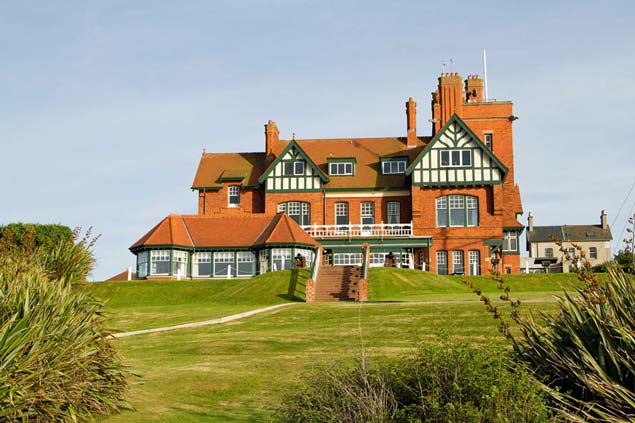 The Royal Ulster YC clubhouse of 1899 was another Vincent Craig creation
The Royal Ulster YC clubhouse of 1899 was another Vincent Craig creation
Vincent didn’t share his brother’s all-or-nothing approach to the developing political situation in Ireland, so around 1912 he took early retirement and went to live in the south of England. However, talk of “early retirement” was only a politeness, as he and his six siblings were extremely rich, thanks to their father’s enormous success as a whiskey distiller. As Vincent’s obituary in 1925 in the Irish Builder delicately put it, “he was never obliged to engage in the rough and tumble of professional practice, or to trouble about business, as he had ample private means”.
Yet his buildings were interesting, while Vilia was almost embarrassingly fast despite being rated as a cruiser. Nevertheless, it’s a reminder that in those heady days of sailing expansion in Ireland as the 1800s became the 1900s, much of it seemed to be funded by a profitable sea of booze, driven along by a wind filled with equally profitable tobacco smoke, all of which looks decidedly murky from health-obsessed 2020.
So you can say what you like about Tommy Lipton and his America’s Cup mania, but at least he made his money out of tea…
Historic Tall Ship 'Eye of the Wind' to Visit Dublin
The traditional Tall Ship sailing vessel "Eye of the Wind" will reach Dublin Port within the next few days.
The "Eye of the Wind" is 109 years old, sails under UK flag, and is considered to be a "sailing legend" in the maritime world.
The arrival is scheduled for September 20. The exact ship's route can be tracked here
In the past, she used to be the flagship of a scientific expedition under the patronage of HRH The Prince of Wales and featured in several Hollywood movie productions.
Tall Ship 'Pelican of London' Returns to Port of Cork
The Tall Ship Pelican of London evoked memories of days gone by alongside at the Port of Cork quays on the River Lee last night writes Bob Bateman.
The part clipper, part pirate ship was back in Cork Harbour a fortnight after her previous visit to the Tall Ship Sail Training Armada & Awards Presentation.
Based in Bristol, the 45-metre Pelican is a three-masted Barquentine that sails throughout the summer on voyages from the UK to European harbours including maritime festivals, historic ports and competing in Tall Ships Races.
One such voyage is currently advertised on the ship's Facebook page: a trip from Cork to Santander at €500 from 6th to 12th September.
 Pelican of London Photo: Bob Bateman
Pelican of London Photo: Bob Bateman


























